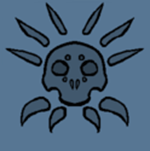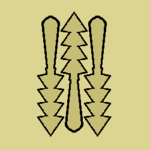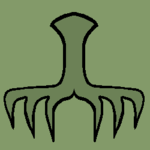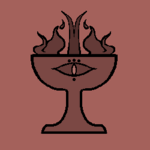Unathi Cults: различия между версиями
imported>Rootoo (Created) |
imported>Rootoo (Adds images) |
||
| Строка 2: | Строка 2: | ||
== The Grand Stratagem == | == The Grand Stratagem == | ||
[[File:Unathi cult grandstratagem.png|thumb|Lhossek skull, a popular symbol of the Stratagem. ]] | |||
According to those involved, The Grand Stratagem dates back to at least '''55 000''' BCE, with the first related artifacts showing up around '''35 000''' BCE. Often called “'''The Old Cult'''”, it is most popular with those in the harsher environments of [[Moghes]], the Deserts and Diamond Peaks, although it is also practiced by many individual clans all over Moghes. The Stratagem preaches that, at some point in the future, the patron spirits of the world are bound to clash with great cosmic evil, to usher in a new era. Since each and every Unathi will participate in the upcoming battle, it is only prudent to start preparing for it the earthly life. | According to those involved, The Grand Stratagem dates back to at least '''55 000''' BCE, with the first related artifacts showing up around '''35 000''' BCE. Often called “'''The Old Cult'''”, it is most popular with those in the harsher environments of [[Moghes]], the Deserts and Diamond Peaks, although it is also practiced by many individual clans all over Moghes. The Stratagem preaches that, at some point in the future, the patron spirits of the world are bound to clash with great cosmic evil, to usher in a new era. Since each and every Unathi will participate in the upcoming battle, it is only prudent to start preparing for it the earthly life. | ||
| Строка 15: | Строка 16: | ||
== The Fruitful Lights == | == The Fruitful Lights == | ||
[[File:Unathi cult fruitfullights.png|thumb|Three Arrows – a quality mark used by some Fruitful Lights Temples.]] | |||
As the populations of the early city-states grew, so did the demand for farming tools and weapons. The guilds emerged as tight-knit groups of skilled craftsmen, with mentors passing trade secrets to the apprentices. Over the years, their lore was accumulated, and finally codified by Algrhass Dhakiss around '''982''' BCE. On that day, the Fruitful Lights were officially born. | As the populations of the early city-states grew, so did the demand for farming tools and weapons. The guilds emerged as tight-knit groups of skilled craftsmen, with mentors passing trade secrets to the apprentices. Over the years, their lore was accumulated, and finally codified by Algrhass Dhakiss around '''982''' BCE. On that day, the Fruitful Lights were officially born. | ||
| Строка 24: | Строка 26: | ||
== Hand of the Vine == | == Hand of the Vine == | ||
[[File:Unathi cult handofvine.png|thumb|Hrukhza bush root is a widespread motif in arts practiced by Hand of the Vine followers.]] | |||
One of the more recent movements, Hand of the Vine appearance in 3,400 BCE roughly corresponds with the beginning of desert recolonisation, – at this point in Unathi history, savanna clans began to migrate back to the lands they one came from, to escape overpopulation and the tyranny of the senior families of their clan. A loosely-affiliated group of semi-nomadic shamans, Hand of the Vine acolytes teach that the, with the help of spirits, Moghes can be reformed and transformed into a paradise world, – enough not only to sustain, but to move Unathi to prominence. | One of the more recent movements, Hand of the Vine appearance in 3,400 BCE roughly corresponds with the beginning of desert recolonisation, – at this point in Unathi history, savanna clans began to migrate back to the lands they one came from, to escape overpopulation and the tyranny of the senior families of their clan. A loosely-affiliated group of semi-nomadic shamans, Hand of the Vine acolytes teach that the, with the help of spirits, Moghes can be reformed and transformed into a paradise world, – enough not only to sustain, but to move Unathi to prominence. | ||
| Строка 33: | Строка 36: | ||
== Precursor == | == Precursor == | ||
[[File:Unathi cult precursor.png|thumb|Precursor sites are often denoted by sundials on local maps.]] | |||
For Unathi faithful, the existence of powerful spirits other than Ancestors wasn't something far-fetched; for those reliant on the wondrous technology left behind by the old ones, this was out of question. Already seen by many as an ancient powerful race, Precursors were elevated to demigod status by some clans, while a few unsophisticated Unathi even confused them with the Ancestors. While moderately widespread, Precursor worship is not universal, and the notion of them being an equal to Ancestors may seem ridiculous to more proud races of Moghes, especially those following the Strategem. | For Unathi faithful, the existence of powerful spirits other than Ancestors wasn't something far-fetched; for those reliant on the wondrous technology left behind by the old ones, this was out of question. Already seen by many as an ancient powerful race, Precursors were elevated to demigod status by some clans, while a few unsophisticated Unathi even confused them with the Ancestors. While moderately widespread, Precursor worship is not universal, and the notion of them being an equal to Ancestors may seem ridiculous to more proud races of Moghes, especially those following the Strategem. | ||
| Строка 40: | Строка 44: | ||
== Markesheli == | == Markesheli == | ||
[[File:Unathi cult markesheli.png|thumb|The much-dreaded Cup of Knowledge.]] | |||
The Cult of Markesh stands apart from other religions of Moghes in many ways. First mentioned in 6,100 BCE, it was almost wiped two millennia later – yet it managed to come back, albeit in a somewhat changed form''.'' A scorned cult, it remains one even after the rebirth, much like its chosen deity; however, since the first contact with the alien races and the discovery of Ouere, public attention was largely diverted from Markesheli activity. While the cult members do not depart entirely from the tenets of traditional religion, they often interpret it in an uncharacteristic and even shocking way; the breaking f public norms have become the norm with this creed. | The Cult of Markesh stands apart from other religions of Moghes in many ways. First mentioned in 6,100 BCE, it was almost wiped two millennia later – yet it managed to come back, albeit in a somewhat changed form''.'' A scorned cult, it remains one even after the rebirth, much like its chosen deity; however, since the first contact with the alien races and the discovery of Ouere, public attention was largely diverted from Markesheli activity. While the cult members do not depart entirely from the tenets of traditional religion, they often interpret it in an uncharacteristic and even shocking way; the breaking f public norms have become the norm with this creed. | ||
Версия от 23:28, 24 апреля 2023
This page details the different aspects of the Unathi cults – the conflict-oriented Grand Stratagem, inquisitive Fruitful Lights, altruistic Hand of the Vine and the mysterious Markesheli. Each cult has it's own philosophy and ideas, although ultimately they are based on the traditional Ancestor religion.
The Grand Stratagem
According to those involved, The Grand Stratagem dates back to at least 55 000 BCE, with the first related artifacts showing up around 35 000 BCE. Often called “The Old Cult”, it is most popular with those in the harsher environments of Moghes, the Deserts and Diamond Peaks, although it is also practiced by many individual clans all over Moghes. The Stratagem preaches that, at some point in the future, the patron spirits of the world are bound to clash with great cosmic evil, to usher in a new era. Since each and every Unathi will participate in the upcoming battle, it is only prudent to start preparing for it the earthly life.
To secure a worthy status in the better world, the followers of the Grand Stratagem seek to achieve the most of their time on Moghes; as such, the cult leans heavily into the philosophy of self-growth and self-improvement. That goes to the extreme; violent conflicts and struggle, hardship and destitution are seen by the faithful ones as mere trials, by which they will prevail.
In their quest, Stratagem followers seek reassurance not only in future, but also in their past. For them, the perfect role models are the mighty Kahhnepos of the past, which the Stratagem faithful seek to emulate; the songs and poems of the heroic acts of old are popular with the cult members. In fact, while the Stratagem has no conventional priesthood of its own, learned individuals with the knowledge of history and law are held in high regard by the cultists, and are often consulted with in a variety of life situations.
Despite some claims, the Stratagem by no means relishes is superfluous mysticism or escapism: the air of superiority it gives to their followers makes them impervious to petty superstitions or gossip, and often less reverential towards magicians and shamans. However, the teachings of the cult do not place great importance in material side of Unathi life; the faithful of the cult are content with the spartan conditions they live in, as far as they have enough to support their young.
In popular imagination, the Champions of the Grand Stratagem are uncouth, rugged individuals who seek the heat of battle or brave the dangers of the natural world. When they aren't doing that, they learn and meditate with their comrades, or seek the only comfort that is fit for them: the company of their spouses and children.
There are some differences in local traditions related to The Grand Stratagem, mainly between Diamond Peaks and Great Desert versions of the cult. The Peak variant is more focused on hierarchy; one of its main tenets is that there are those who lead and those who obey: natural-born leaders and natural-born servants. While the vassals busy themselves with farming and supplying their overlords, the highland elite practices their skills in martial arts and crafts, to protect their “weaker” subjects. At the same time, Desert Stratagem followers are more egalitarian in that aspect, but also somewhat less refined. While the Peakies prefer to maintain balance between body and mind, the desert Unathi gravitate towards the former, with strength and resilience praised as great virtues. A major, ceremonial aspect of the Desert variant of the cult are the so-called "Pits." Pits are often in the center of clan communities and are meant as a sort of gladiatorial arena where Unathi can test themselves against each other or captured fauna. On the day of the summer solstice Desert clans celebrate those who have survived, and learn from those who have not. Many Unathi will place items that remind them of the dead of their clan in the ritual bonfires as an act of remembrance and respect.
The Fruitful Lights
As the populations of the early city-states grew, so did the demand for farming tools and weapons. The guilds emerged as tight-knit groups of skilled craftsmen, with mentors passing trade secrets to the apprentices. Over the years, their lore was accumulated, and finally codified by Algrhass Dhakiss around 982 BCE. On that day, the Fruitful Lights were officially born.
In fact, The Fruitful Lights cult existed since 9,500 – 9,400 BCE, when a large temple in Si'gek Nels'thar was estabilished, funded by local guilds. The Jhoges and members of said guilds were dedicated to researching the material world – looking into the inner workings of each entity and the forces behind them. Through this, they believed, they could achieve higher attunement with the spirits of the world, and create a harmonious society based on it.
Although initially the cult members did not seek to proselytize, Fruitful Lights teachings spread quickly to the most urbanised parts of Moghes – both Poles and major city-states and fortresses everywhere. The followers of the cult practice alchemy, astrology, medicine and other crafts; due to primitive methods and fundamental misconceptions, those lengthy studies were often in vain, although some resulted in practical achievements, especially in the field of material studies. The scholars of Fruitful Lights mapped the world and the sky; described every single type of mineral on Moghes with all their real and attributed traits; drew connections between the position of stars and planets and the past, ongoing and future events; created countless works of art; improved metallurgy and much more, all while leaving behind thousands of tracts on different topics. A typical Fruitful Lights cultist will have several books in their possession, along with a collection of items related to the issue that interests them; their clothes may be adorned by hundreds of amulets, pendants and other trinkets that are said to amplify their natural abilities – or might be used in other most practical ways.
While the Fruitful Lights don't have religious leaders per se, the masters of certain recognised crafts command enough respect to be followed by the adepts and students of said craft. The cult itself is centered around temples maintained in the city-states and other locations by affiliated guilds. Although full cult membership is essentially restricted to the tradesmen, the sages of Fruitful Lights are held in high regard by general populace, including the members of other cults.
Hand of the Vine
One of the more recent movements, Hand of the Vine appearance in 3,400 BCE roughly corresponds with the beginning of desert recolonisation, – at this point in Unathi history, savanna clans began to migrate back to the lands they one came from, to escape overpopulation and the tyranny of the senior families of their clan. A loosely-affiliated group of semi-nomadic shamans, Hand of the Vine acolytes teach that the, with the help of spirits, Moghes can be reformed and transformed into a paradise world, – enough not only to sustain, but to move Unathi to prominence.
Those who follow the doctrines of Hand of the Vine preach unity and benevolence towards the natural world. Instead of consuming, they are dedicated to the spreading and breeding of all plant and animal life.
While the cult itself is far from being ubiquitous, its traditions and rites have gained massive traction among rural population of Moghes – that is, the majority of its inhabitants. Hand of the Vine Acolytes travel the world is small groups, carrying bags with thousands of seeds, which they call "Her Hands" – they are welcome in all settlements, where they hold feasts and rituals dedicated to Moghes, Ancestors, fertility and peace; although the stuck-up leaders of the Strategem and Fruitful Lights may look down on them, Hand of the Vine shamans are respected by the general population. Moreover, the colourful theatrics of its festivals make it attractive to children, who are eager to participate.
With the establishment of city-states, Moghes has had a recent shift in some beliefs in the hand of the vine. With agricultural advancements shooting upwards, and a combination of technologies borrowed from humans and Skrell, a new style of follower arose that settled upon the land, raising livestock and crops for consumption and exports. Known as Ksisk, these Unathi pride themselves on their vast agricultural fields, feeding not only the City-States, but funding themselves through exports of exotic Unathi crops.
Precursor
For Unathi faithful, the existence of powerful spirits other than Ancestors wasn't something far-fetched; for those reliant on the wondrous technology left behind by the old ones, this was out of question. Already seen by many as an ancient powerful race, Precursors were elevated to demigod status by some clans, while a few unsophisticated Unathi even confused them with the Ancestors. While moderately widespread, Precursor worship is not universal, and the notion of them being an equal to Ancestors may seem ridiculous to more proud races of Moghes, especially those following the Strategem.
Although not a centralized or uniform cult, Precursors worship is mainly centered around the artifacts left behind by the ancient inhabitants of Moghes. Followers of the Precursors vary in their beliefs – some think that learning and understanding the Precursors (and what happened to them) will ultimately make the Unathi wiser, while others simply revere Precursor ruins and related items, which they believe have magical properties.
Due to its association with Precursor sites, Precursor worship is most commonly practiced by Unathi of the Poles and peoples of the Desert, with clan Ba'ask being one of the most notable Precursor clans.
Markesheli
The Cult of Markesh stands apart from other religions of Moghes in many ways. First mentioned in 6,100 BCE, it was almost wiped two millennia later – yet it managed to come back, albeit in a somewhat changed form. A scorned cult, it remains one even after the rebirth, much like its chosen deity; however, since the first contact with the alien races and the discovery of Ouere, public attention was largely diverted from Markesheli activity. While the cult members do not depart entirely from the tenets of traditional religion, they often interpret it in an uncharacteristic and even shocking way; the breaking f public norms have become the norm with this creed.
According to the legends, a Precursor by the name of Markesh was the only survivor of the catastrophic fire which swallowed the planet some hundred thousand years ago, turning it into a wasteland. Markesh was essentially stuck between two worlds, having departed from that of the living yet rejected by that of the dead. He was doomed to walk the ravaged sands of Moghes for eternity, witnessing the end of the planet and his race. One day however, Markesh discovered an egg; from this egg, hatched by Markesh, came the first Unathi. According to those involved with the cult, Markesh the Father taught the first Unathi all he learned from his agonising existance; it is unclear what came next, but it is assumed that, once he was through, he finally ascended to the afterlife, either pardoned by the spirits or emerging as a more powerful entity.
It is generally believed that the secret knowledge passed down from Markesh himself served as a basis for the cult, although in its impure form. Once the ancient lore is restored, one of the most devout cult members will be reborn as the Father, and will end his childrens' struggles by leading the Unathi to a form of transcendental paradise, known as "The Land Once Went".
In its early form, the Cult of Markesh evolved from arcane practices of the preachers that roamed the borderlands between Savannas and the Great Desert some 10,000 years ago. While some of their beliefs eventually evolved into Hand of the Vine doctrines, there were other more questionable practices. These were the times of widespread anxiety over the changes in the traditional way of life; having depleted the pastures, many clans struggled to settle down, and were faced with more and more questions about their future.
The Preachers of Markesh gave the answers. They brought in dark rituals, violence and sacrifice – but also strict discipline and unity no one has seen before. In a series of brutal reprisals, they are said to have driven entire villages to collective madness and devastation, although not before accepting the converts as new apprentices. The cult spread fast, and soon many clans found themselves expelling the adepts from their ranks in pursuit of safety.
While it stopped the meteoric rise of the cult, the so-called First Expulsion of Markesheli (5,226 – 5,220 BCE) led to consolidation of the cult's realm, and its first organised campaigns. The drums of war beat, and the riders of Markesh gathered into an unstoppable horde. The Unathi were used to constant small-scale clashes between clans over territory or the matters of honor – the colonial aspirations of Diamond Peak chiefdoms introduced them to a more organised form of warfare. Yet, the events of the Cult War – which laid Southern Savannas to waste – were unparalleled in Sinta memory, and they still are.
In the wake of a series of defeats inflicted on them by the armies of Kaahnepo Ssvagha Issarik, the cult began to crumble under its own weight. Disillusionment in the leadership, continued persecution (Markesheli were excluded from the polar dominions in 4,311 BCE) and harvest failures led to the return of many new converts and their descendants to the original clans. The news spread, and the biggest weapon of the cult – terror – was quickly waning. A major coup came with the mass slaughter of alleged Markesheli members and sympathisers in the Diamond Peaks, perpetrated by Stratagem zealots in 4,267 BCE – although this led to almost a century of instability and infighting, the strength of the cult was broken. In few decades, Markesheli fell into obscurity, leaving behind nothing but few ruins and the stories of their exploits.
Time has passed since then; the balance of population and economic power shifted from the equator of Moghes towards its poles. Large slums sprung up around major city states; those lawless communities proved to be a perfect ground for Markesheli rebirth. By the turn of 23rd century, the cult experienced a renaissance, its learned ascetics preaching enlightenment for the downtrodden of the poles. Although the leadership of the city-state would rather Markesheli not being around their area of responsibility, in the face of popular discontent the majority of Kaahnepos opted for a more careful approach, tolerating or at least avoiding direct conflict with the cultists. As the result, even though only a small minority of contemporary population practices Markesheli religion, those who do live compactly in large urban areas, – the east outskirts of Mumbak are a particularly prominent example, known popularly as "Markesheli Territory".




